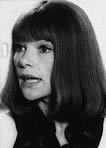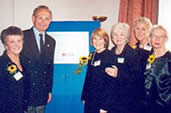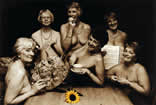|
"We
didn't expect this much fuss. While we were doing it, we
were a bit nervous at first. But it ended up being good
fun thanks to quite a lot of red wine."
- Rosalyn Fawcett ("Miss November 2000" - Age
49)
Questioning the Story:

Was each actress in the film based on one of the real
life calendar girls?
No.
Much of the film was fictionalized, including the majority
of the characters and their names. Similar situations obviously
arose, such as Julie Walters' character's husband being
diagnosed with leukemia, but the conglomeration of women
in the film was created for the movie's story. It was not
intended to represent the actual group of women. Intentional
similarities do exist when comparing the close friendship
of Annie (Julie Walters) and Chris (Helen Mirren) to that
of Angela Baker and Tricia Stewart in real life. -BBC
Why did the women decide to do the calendar?
 The
women decided to do the calendar to raise money to help
fight leukemia after Angela Baker's husband John died from
non-Hodgkin's lymphoma in July 1998 at age 54. John Richard
Baker (pictured right) was a loving husband and worked as
an Assistant National Park Officer for the Yorkshire
Dales National Park Authority. From the onset
of his illness, John grew sunflowers and gave them to his
friends and family, hoping that he would recover by the
time that they bloomed. Unfortunately, this was not the
case, yet the image of the sunflower remained as a reminder
of John and a symbol of the group's fund raising for leukaemia
and lymphomas. The image of the sunflower is present throughout
the calendars. -BBC The
women decided to do the calendar to raise money to help
fight leukemia after Angela Baker's husband John died from
non-Hodgkin's lymphoma in July 1998 at age 54. John Richard
Baker (pictured right) was a loving husband and worked as
an Assistant National Park Officer for the Yorkshire
Dales National Park Authority. From the onset
of his illness, John grew sunflowers and gave them to his
friends and family, hoping that he would recover by the
time that they bloomed. Unfortunately, this was not the
case, yet the image of the sunflower remained as a reminder
of John and a symbol of the group's fund raising for leukaemia
and lymphomas. The image of the sunflower is present throughout
the calendars. -BBC
As in the film, did the other women of the WI really
at first frown at the idea of the calendar?
No. Unlike in the film, the other members of the Women's
Institute showed nothing but support for the calendar. This
included the local group and the national organization as
well. -BBC
How old were the women when the photos were taken?
 The
models ranged in age from 45 to 65 when the photos were
taken. Miss January, Beryl Banforth, was the oldest at 65.
She is a retired secretary and posed in a photo chairing
a meeting of women wearing nothing but hats (right). -BBC The
models ranged in age from 45 to 65 when the photos were
taken. Miss January, Beryl Banforth, was the oldest at 65.
She is a retired secretary and posed in a photo chairing
a meeting of women wearing nothing but hats (right). -BBC
Who took the photos for the calendar in real life?
The photos were taken by Terry Logan, who was the husband
of Lynda Logan, one of the models. Terry was a former professional
photographer. Lynda and Terry also had a family connection
as to why the calendar was made. Lynda and Terry's daughter
Georgina is married to Matthew the son of John and Angela
(Miss February). Angela, Lynda and Terry share in the delight
of their granddaughters Helena and Kristina. -CalendarGirls.tv
Did the husbands really see the photographs prior to
the calendar's official release?
In the film, the husbands, including Jem and Gaz, see the
photographs prior to the launch of the calendar. In real
life the husbands did not see the photographs until the
day the calendar was released. This is of course with the
exception of the photographer Terry Logan, who was the husband
of one of the women. -BBC
When was the calendar officially released and how successful
was it?
The self-published Alternate WI Calendar, as it had been
named, was released officially on April 12, 1999.
It was an instant sensation with the first printing selling
out in a week. 10,000 more copies were made during a massive
second printing and that load was gone after just three
more weeks. Word spread quickly about the calendar, and
the international press soon jumped on the story. By December
of 1999, just nine months after its launch, the calendar
had sold 88,000 copies, and raised some $550,000 for leukemia
research. That number has grown significantly since then,
especially after Workman Publishing released an American
version of the calendar. -Spectator.net
Were there any other factors responsible for the calendar's
early success?
 Actress
Glenda Jackson (right) was one of the calendar's sponsors,
which likely helped to ignite interest. Jackson is a member
of the British Parliament where she serves as Labour MP
for Hamstead and Highgate. She is the only British Parliament
Member to have won an Oscar. Glenda Jackson won a Best Actress
Oscar for her role in the D.H. Lawrence adaptation Women
in Love (1969). She won a second Academy Award for her
performance in 1973's A Touch of Class. Obviously
in addition to Glenda Jackson's support, the whole nude
aspect of the calendar likely garnered quite a bit of interest
on its own. -IMDB.com Actress
Glenda Jackson (right) was one of the calendar's sponsors,
which likely helped to ignite interest. Jackson is a member
of the British Parliament where she serves as Labour MP
for Hamstead and Highgate. She is the only British Parliament
Member to have won an Oscar. Glenda Jackson won a Best Actress
Oscar for her role in the D.H. Lawrence adaptation Women
in Love (1969). She won a second Academy Award for her
performance in 1973's A Touch of Class. Obviously
in addition to Glenda Jackson's support, the whole nude
aspect of the calendar likely garnered quite a bit of interest
on its own. -IMDB.com
How many of the women ended up selling their story to the
filmmakers?
Six of the eleven women sold the rights to their stories,
including Ms Stewart, Ms Baker, Ms Bamforth, Lynda Logan,
Christine Clancy and Ros Fawcett. -BBC
Did the bitter argument between Annie (Julie Walters) and
Chris (Helen Mirren) that occurred in the film also happen
in real life?
In her BBC review of the film, real life calendar girl Tricia
Stewart explained that the argument that arose between Annie
and Chris in the film did not happen between any of the
girls in real life. However, as she went on to say in her
review, the calendar did expose certain jealousies and insecurities
among the women. -BBC
What were the results of the fundraising?
 In
2000, the calendar had raised more than £450,000.
The money was used to fund cutting edge research into lymphoma
and leukaemia at the University of Leeds. A plaque dedicated
to John Baker was placed in new laboratories at Leeds. The
plaque reads, "The work in this laboratory is dedicated
to the memory of John Baker in recognition of the exceptional
fundraising achievements of ‘The Calendar Girls’
of the Rylstone & District Women’s Institute."
Above right is a photo from the ceremony (pictured in the
photo is Leukaemia Research Fund Chief Executive Douglas
Osborne with Calendar Girls, left to right, Christine Clancy,
Angela Baker, Lynda Logan, Tricia Stewart and Beryl Bamforth).
-Leukaemia Research Fund In
2000, the calendar had raised more than £450,000.
The money was used to fund cutting edge research into lymphoma
and leukaemia at the University of Leeds. A plaque dedicated
to John Baker was placed in new laboratories at Leeds. The
plaque reads, "The work in this laboratory is dedicated
to the memory of John Baker in recognition of the exceptional
fundraising achievements of ‘The Calendar Girls’
of the Rylstone & District Women’s Institute."
Above right is a photo from the ceremony (pictured in the
photo is Leukaemia Research Fund Chief Executive Douglas
Osborne with Calendar Girls, left to right, Christine Clancy,
Angela Baker, Lynda Logan, Tricia Stewart and Beryl Bamforth).
-Leukaemia Research Fund
How did Angela Baker feel about the worldwide response
to the calendar?
In an interview John Baker's wife, Calendar Girl Angela
Baker, said the following, "We are constantly amazed
at the response we had, and still get, to our Calendar.
I cannot believe that we were able to raise so much money
and I am delighted that it is being spent on such worthwhile
research. I know that John would be tremendously honored
to know that we have achieved so much in his name."
-LRF
Have the women appeared in any other fundraising photos?
 In
addition to the calendars, six of the original WI Calendar
women posed for a postcard titled "Baker's Half Dozen"
(shown at left - click to enlarge). The women include Lynda
Logan, Beryl Bamforth, Tricia Stewart, Christine Clancy,
Angela Baker and Ros Fawcett. In
addition to the calendars, six of the original WI Calendar
women posed for a postcard titled "Baker's Half Dozen"
(shown at left - click to enlarge). The women include Lynda
Logan, Beryl Bamforth, Tricia Stewart, Christine Clancy,
Angela Baker and Ros Fawcett.
The
Calendars at a Glance:
Browse
the two calendars, including the original WI Calendar and
the new calendar featuring the women from the film with some
of the original calendar girls.
Buy the 2004 Calendar available from Amazon UK.
Link
to Learn More:
 Calendar
Girls/ Roger Ebert's Review
Calendar
Girls/ Roger Ebert's Review 
 Real
Life Calendar Girl Tricia Stewart Reviews the Film Real
Life Calendar Girl Tricia Stewart Reviews the Film
 The
Women's Institute The
Women's Institute
 Yorkshire
Tourist Board - Explore Yorkshire Yorkshire
Tourist Board - Explore Yorkshire
Watch
the Calendar Girls Movie Trailer:
Message Board (Discuss the Film):

|
